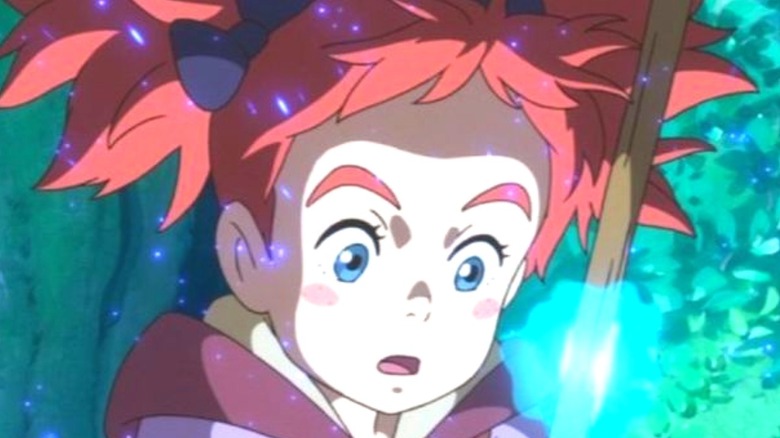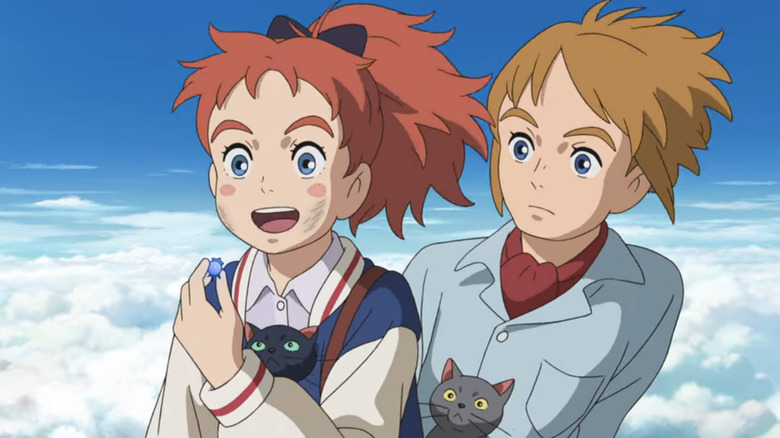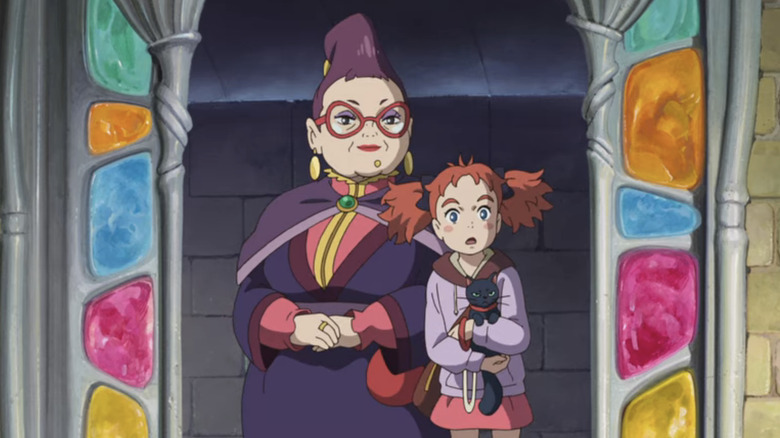The Ending Of Mary And The Witch's Flower Explained
The anime fantasy hidden gem "Mary and the Witch's Flower" is currently streaming on Netflix, and it's a perfect watch for lovers of Studio Ghibli's whimsical animation style. Directed by Hiromasa Yonebayashi and produced by Yoshiaki Nishimura — who both had their starts at Studio Ghibli — "Mary and the Witch's Flower" is based on Mary Stewart's novel "The Little Broomstick."
"Mary and the Witch's Flower" tells the story of Mary Smith (voiced by Hana Sugisaki in the Japanese version, Ruby Barnhill in English), a girl who moves to a new town with her great-aunt Charlotte (Shinobu Otake and Kenichi Endō/Lynda Baron and Teresa Gallagher). While exploring with a local boy named Peter (Ryunosuke Kamiki/Louis Ashbourne Serkis) and his cats, they stumble upon magical flowers called fly-by-nights that give off temporary magic powers.
Mary soon finds herself whisked away to a witch boarding school called Endor after one of the fly-by-nights bursts on her broomstick and renders it flyable. The school headmistress Madam Mumblechook (Yūki Amami/Kate Winslet) mistakes Mary for a real witch, and Mary decides to use the powers for as long as she can. However, she soon realizes that not everyone at Endor is who they appear to be.
"Mary and the Witch's Flower" is an enchanting movie that teaches some poignant lessons about growing up. Here is the film's ending explained.
Mary and the Witch's Flower is about being good enough as you are
One of the most common themes throughout Studio Ghibli's oeuvre is self-discovery, and "Mary and the Witch's Flower" is another prime example of Ghibli alum utilizing the powerful message. The film starts with Mary feeling out of place, constantly doing her chores wrong and being a general klutz. As soon as she discovers the magic of the fly-by-nights, however, she has the power to literally transform herself and accomplish amazing tasks.
It's a great power, but Mary ultimately decides that she's just as capable of doing outstanding things just the way that she is, and doesn't need magic after all. Instead, she focuses on her natural strengths — her loyalty to her friend, her bravery — in order to save the day. She even goes so far as to throw the remaining fly-by-night away, signifying that she is truly done with magic. This gesture is Mary's way of declaring her self-worth, and making it clear that she's fully confident in herself — which is a stark contrast from the Mary we met at the beginning of the movie.
It's symbolic of Studio Ponoc's journey
While "Mary and the Witch's Flower" is in itself a testament to Studio Ghibli with its similar themes and style, it also serves as a symbol for the new studio the Ghibli animators created. After Yonebayashi and Nishimura left Studio Ghibli, they created their new production studio, Studio Ponoc, as a way to keep creating meaningful animated movies. The name is symbolic of this change as well — according to their website, the name Ponoc "comes from the Croatian word 'midnight' (ponoć), which means the beginning of a new day." Though Yonebayashi and Nishimura spent many years creating amazing work at Ghibli, it was their time to branch out and create something new, much like their fitting name suggests.
Nishimura spoke to The Mary Sue about this big change for the animators, and how it mirrored Mary's journey. "I thought this would be a good theme to use for the first film that we produced at Studio Ponoc: after we had left the magical umbrella of Studio Ghibli, we are taking the next step on our own with our own strength," he said. "And also, the world is full of losing many things as we go forward in our lives, so to have the courage to take the next step forward to do something in our life, I hope that this will be able to give that kind of encouragement to the audience."


